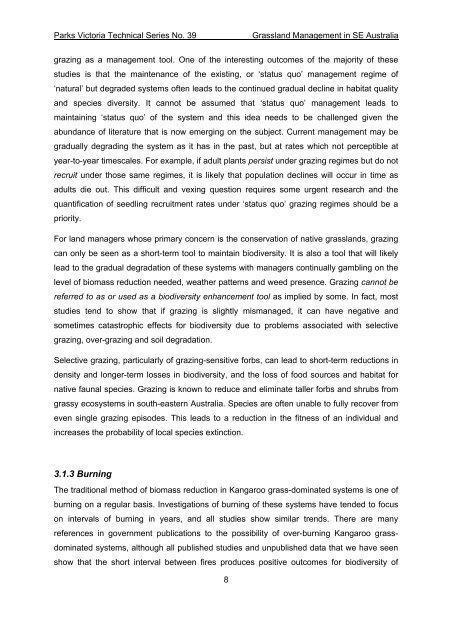Review of Grassland Management in south-eastern ... - Parks Victoria
Review of Grassland Management in south-eastern ... - Parks Victoria
Review of Grassland Management in south-eastern ... - Parks Victoria
Create successful ePaper yourself
Turn your PDF publications into a flip-book with our unique Google optimized e-Paper software.
<strong>Parks</strong> <strong>Victoria</strong> Technical Series No. 39<br />
<strong>Grassland</strong> <strong>Management</strong> <strong>in</strong> SE Australia<br />
graz<strong>in</strong>g as a management tool. One <strong>of</strong> the <strong>in</strong>terest<strong>in</strong>g outcomes <strong>of</strong> the majority <strong>of</strong> these<br />
studies is that the ma<strong>in</strong>tenance <strong>of</strong> the exist<strong>in</strong>g, or ‘status quo’ management regime <strong>of</strong><br />
‘natural’ but degraded systems <strong>of</strong>ten leads to the cont<strong>in</strong>ued gradual decl<strong>in</strong>e <strong>in</strong> habitat quality<br />
and species diversity. It cannot be assumed that ‘status quo’ management leads to<br />
ma<strong>in</strong>ta<strong>in</strong><strong>in</strong>g ‘status quo’ <strong>of</strong> the system and this idea needs to be challenged given the<br />
abundance <strong>of</strong> literature that is now emerg<strong>in</strong>g on the subject. Current management may be<br />
gradually degrad<strong>in</strong>g the system as it has <strong>in</strong> the past, but at rates which not perceptible at<br />
year-to-year timescales. For example, if adult plants persist under graz<strong>in</strong>g regimes but do not<br />
recruit under those same regimes, it is likely that population decl<strong>in</strong>es will occur <strong>in</strong> time as<br />
adults die out. This difficult and vex<strong>in</strong>g question requires some urgent research and the<br />
quantification <strong>of</strong> seedl<strong>in</strong>g recruitment rates under ‘status quo’ graz<strong>in</strong>g regimes should be a<br />
priority.<br />
For land managers whose primary concern is the conservation <strong>of</strong> native grasslands, graz<strong>in</strong>g<br />
can only be seen as a short-term tool to ma<strong>in</strong>ta<strong>in</strong> biodiversity. It is also a tool that will likely<br />
lead to the gradual degradation <strong>of</strong> these systems with managers cont<strong>in</strong>ually gambl<strong>in</strong>g on the<br />
level <strong>of</strong> biomass reduction needed, weather patterns and weed presence. Graz<strong>in</strong>g cannot be<br />
referred to as or used as a biodiversity enhancement tool as implied by some. In fact, most<br />
studies tend to show that if graz<strong>in</strong>g is slightly mismanaged, it can have negative and<br />
sometimes catastrophic effects for biodiversity due to problems associated with selective<br />
graz<strong>in</strong>g, over-graz<strong>in</strong>g and soil degradation.<br />
Selective graz<strong>in</strong>g, particularly <strong>of</strong> graz<strong>in</strong>g-sensitive forbs, can lead to short-term reductions <strong>in</strong><br />
density and longer-term losses <strong>in</strong> biodiversity, and the loss <strong>of</strong> food sources and habitat for<br />
native faunal species. Graz<strong>in</strong>g is known to reduce and elim<strong>in</strong>ate taller forbs and shrubs from<br />
grassy ecosystems <strong>in</strong> <strong>south</strong>-<strong>eastern</strong> Australia. Species are <strong>of</strong>ten unable to fully recover from<br />
even s<strong>in</strong>gle graz<strong>in</strong>g episodes. This leads to a reduction <strong>in</strong> the fitness <strong>of</strong> an <strong>in</strong>dividual and<br />
<strong>in</strong>creases the probability <strong>of</strong> local species ext<strong>in</strong>ction.<br />
3.1.3 Burn<strong>in</strong>g<br />
The traditional method <strong>of</strong> biomass reduction <strong>in</strong> Kangaroo grass-dom<strong>in</strong>ated systems is one <strong>of</strong><br />
burn<strong>in</strong>g on a regular basis. Investigations <strong>of</strong> burn<strong>in</strong>g <strong>of</strong> these systems have tended to focus<br />
on <strong>in</strong>tervals <strong>of</strong> burn<strong>in</strong>g <strong>in</strong> years, and all studies show similar trends. There are many<br />
references <strong>in</strong> government publications to the possibility <strong>of</strong> over-burn<strong>in</strong>g Kangaroo grassdom<strong>in</strong>ated<br />
systems, although all published studies and unpublished data that we have seen<br />
show that the short <strong>in</strong>terval between fires produces positive outcomes for biodiversity <strong>of</strong><br />
8

















